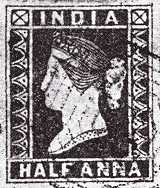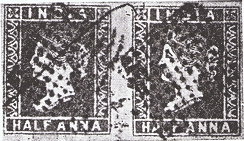
Figure1. Half Anna with One Anna Corners |
Once upon a time I had an idea that the "classics" were out of my reach as far as my pocketbook was con-cerned. I wanted to collect them. in fact, I had a few of the common ones, but I knew that the great majority were listed in Scott's at $2 or $3 or at $5 to $10, or even on up to hundreds of dollars apiece. Manifestly, at those figures, it would be impossible for an ordinary, every-day sort of person to aspire to such things.
Then, a good many years ago, there came an opportunity one day to buy an old collection that was partly stuck down tight and partly mounted on home-made hinges. It was contained in an old International album and had been formed between 1897 and 1902, since when it had laid upon a library shelf in a minister's home. This col-lection had been offered to several New York dealers but none was in-terested because of its untidy condi-tion.
To make a long story short, the collection came to my attention finally and the price asked was reasonable. After only a casual inspection I knew that, without a doubt, I had to have it. For it was obvious that two-thirds of its stamps could be damaged or de-fective or forgeries and it still would be a marvelous bargain. So I bought it.
In later articles I will be referring to this collection frequently for some of my finest stamps have come from it: a St. Louis Bear stamp, a New York Postmaster's Provisional, early pence issues of Canada, Sydney Views, Early Brazil, etc., etc.
One of the stamps from this collec-tion which I transferred to my own album very soon was India No. 1 -- or, at least, that is what I thought it was. The trouble, however, was that it had been postally used and Scott says of India No. 1: "No. 1 was not placed in use." It was a half anna stamp all right and it looked like the picture in the catalogue and it was red or ver-milion red in color. So the cancella-tion was a mystery.
I sent my problem to an "expert" in England who conducts a regular department in one of our prominent philatelic newspapers and his answer, probably given without too much thought in the matter, was that. "it probably is No. 7." This was a rather silly answer because No. 7 is a one anna stamp and this was plainly marked "half anna."
The reply had its value though for it caused me to examine the stamp more closely and, upon doing so, I found it to be a little bit different than the illustration in the catalogue since while otherwise it looked like the half anna one, yet the upper corners were more like the ones in the picture of the one anna type.
Next, then, I took it to B. W. H. Poole of Los Angeles, a recognized authority on early 'British Empire but he could not solve the mystery either. He did say, though, that he thought the postmark was genuine since it was identical with the Bengal type as used in Calcutta in 1861.
It was not until May of 1949 that the matter was cleared up. Early that month I received a catalogue from Robson Lowe of London for their auction sale of late May of the world-famous collection of India which had been made by the late C. D. Desai of Bombay. And, wonderful to say, on page 8 of that catalogue there it was, illustrated. The caption said "1/2 Anna Essay with 1 Anna Cor-ners." I learned that it had been printed not only in vermilion red but also in black, blue, orange-red and deep red. What probably happened was that this copy fell into the hands of someone who used it for postage, which does occur sometimes with essays, especially those which, as in this case, closely resemble the official issue.
This 1/2 anna with 1 anna corners is illustrated here. I am very
proud of it and it occupies a prominent position in my collection of India.

Figure1. Half Anna with One Anna Corners |
Now for the story of the officially issued half anna stamps. The
first ones were put out October 1, 1854 and are found in blue, pale blue,
deep blue and indigo and also come in two dif-ferent dies: I and 11.
A third die, III, was used later and the first exam-ples from it appeared
in July, 1855. Die III comes in blue and greenish -blue. Illustrated
here are a pair of Die I and single specimens of II and III. They
are so identified because of certain characteristics which are reasonably
constant.

Figure 2. Die I |
|
|
|
Die I has long points on the stars in the corner ornaments and the middle and right jewels in the diadem show clearly defined crosses. In Die- II the chignon has less shading than in Die I and the band of the diadem is heavily shaded. Die III has very little if any shading on the band of the diadem and the stars in the corner ornaments have very little color in them.
There are literally hundreds of varieties since ten different parent stones were used in printing as well as a number of sub-stones which had been transferred from the parent stones. As to numbers printed there were about thirty millions of Die 1; 2,006,304 of Die II, and 4,750,000 of Die III.
The stamps illustrated here to depict the three Dies are also of further interest in that they show three dif-ferent postal markings of that period. On the pair from Die I we see the first type of obliterator which was issued to all offices on October 1, 1854 at the same time the stamps them-selves were put out. It consists of a diamond of dots and the number of dots vary, there being 9x9, 8x8, 8x9, 8x10, 9x10, 9x12, 10x10, 10x11, 11x11 and 11xl2. This is the 11x11 type. These markings were generally super-seded in 1856 by obliterators showing the town either by name or by number.
The cancellation on the example of Die II is known as the "1861 circle" and was obviously applies in Calcutta as the "TTA" and the upper point of the number "1" in the square indi-cate. On the Die III stamp we find the "Bengal circle" again with "B" for Bengal and "1" for Calcutta surrounded by two broken and four un-broken octagons. This was used from 1854 on.
The half anna blue normally is found imperforate but is known pin-perforated 18 to 22. It was litho-graphed by the Survey Office in Cal-cutta.
It is truly one of the splendid examples of a "classic stamp."